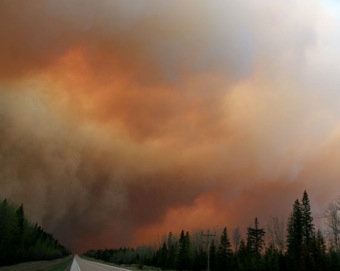New research includes first-ever global death toll from landscape fires: more than 300,000

Research continues to suggest that this century will be a brutal one for wildfires.
The reasons seem pretty straightforward: “The warmer it gets, the more fires we have,” fire scientist Mike Flannigan told reporters at a major science conference in Vancouver this weekend. Flannigan is a professor at the University of Alberta and also works for Canada’s natural resources agency.
Flannigan says fires already claim an area roughly the size size of India each year (If you’re wondering how that’s even possible, he says the acreage includes grasslands, which can actually burn more than once a year). And he says the toll will rise, driven by three main factors:
- The warmer it is, the longer the fire season
- The warmer it is, the more lightning strikes occur
- The warmer it is, the drier the “fuels” waiting to ignite
Flannigan’s colleague at Ontario’s Wilfrid Laurier University, Douglas Woolford, confirmed that in western Canada, the fire season has been growing steadily longer, something fire officials in California say have observed, also. And given the bone-dry winter we’re having, the 2012 fire season could be that much longer and more severe in California.
[module align=”left” width=”half” type=”pull-quote”]”It’s going to be incredibly difficult in the future, to manage forest fires.”[/module]
To monitor fire activity, Flannigan’s team uses an index called “cumulative daily severity,” which he says is rising globally. He says that in the northern hemisphere, that measure could double or even triple by 2070. “It’s going to be incredibly difficult in the future, to manage forest fires,” Flannigan told reporters at a news briefing. “The intensity of fires is going to be increasing and that changes the strategy of putting fires out.”
Flannigan explained that more intense fires can’t simply be confronted head-on. They have to be attacked “at the flanks,” which requires more equipment and manpower, and airborne assaults aren’t as effective. “I would argue that the standard way of doing fire management will no longer be effective in the future.”
As the burned acreage rises, so does the economic toll. Flannigan cited a single fire in Alberta that racked up more than $700 million in costs last year. He says there’s an urgent need for more public education on fire prevention, as most wildfires are caused by human activity.
Also revealed at the AAAS annual meeting was possibly the first-ever global estimate of fire-related mortality. Based on data collected over a ten-year period, Respiratory health researcher Fay Johnston puts the annual death toll related to “landscape fires” at about 340,000. Her work was published this weekend in the journal Environmental Health Perspectives. Johnson says nearly half the victims are typically in Asia and Africa, with 100,000 in southeast Asia alone. She says fires from deforestation are a major contributor — and unlike many other fires, are avoidable.
One thought on “Wildfire Trends: You Ain’t Seen Nothin’ Yet”
Comments are closed.


So increase the use of prescribed fire now. Reocurring peridic fire is an integral part of many healthy ecosystems. Lack of fire has created a high potential for catastrophic fire.